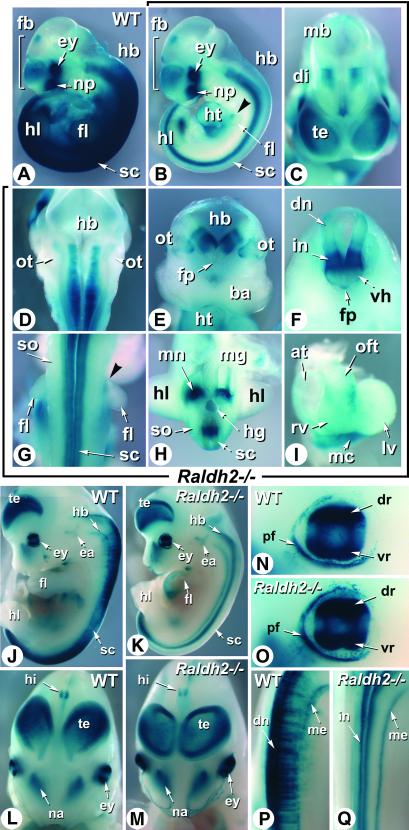Fig 1.
RARE-hsp68-lacZ reporter transgene activity in E10.5 and E12.5 rescued Raldh2−/− embryos. (A and B) WT and mutant (Raldh2−/−) embryos obtained after dietary RA supplementation from E7.5 to E8.5 were concomitantly stained with X-Gal. Shown are profile views. The Raldh2−/− embryo exhibits a hypoplastic forelimb bud (see ref. 23), but otherwise no external defect. (C–I) Details of the RA reporter patterns in the Raldh2−/− embryo. Frontal view of the forebrain region (C), dorsal view of the hindbrain region after removal of the roof plate (D), transverse section of the hindbrain just rostrally to the otocysts (E), transverse section of the cervical spinal cord (F), dorsal view of the forelimb bud region (G), transverse section of the trunk region at the posterior edge of the hindlimb buds (H), frontal view of the dissected heart (I). Arrowheads in B and G point to a patch of transgene expression in the proximal-rostral aspect of the mutant forelimb bud. (J and K) WT and mutant E12.5 transgenic embryos obtained after dietary RA supplementation from E7.5 to E9.5. Shown are profile views. Mutant forelimb development is selectively altered under these conditions (see ref. 24). (L–Q) Comparison of the RA reporter patterns in the craniofacial and forebrain regions (L and M), eye (N and O), and cervical spinal cord (P and Q) of WT and Raldh2−/− embryos, respectively. at, atria; ba, first branchial arch; di, diencephalon; dn, dorsal neurons; dr, dorsal retina; ea, ear; ey, eye; fb, forebrain; fl, forelimb bud; fp, floor plate; hb, hindbrain; hg, hindgut; hi, hippocampal region; hl, hindlimb bud; ht, heart; in, interneurons; lv, left ventricle; mb, midbrain; mc, mesocardium; me, meninges; mg, midgut; mn, mesonephros; na, nasal region; np, nasal placode; oft, outflow tract; ot, otocyst; pf, palpebral fissure; rv, right ventricle; sc, spinal cord; so, somites; te, telencephalic vesicle; vh, ventral horn; vr, ventral retina. (Magnifications: ×4, J and K; ×6, A and B; ×8, L and M; ×10, D; ×12, C, E–H, P, and Q; ×15, I; ×20, N and O.)

